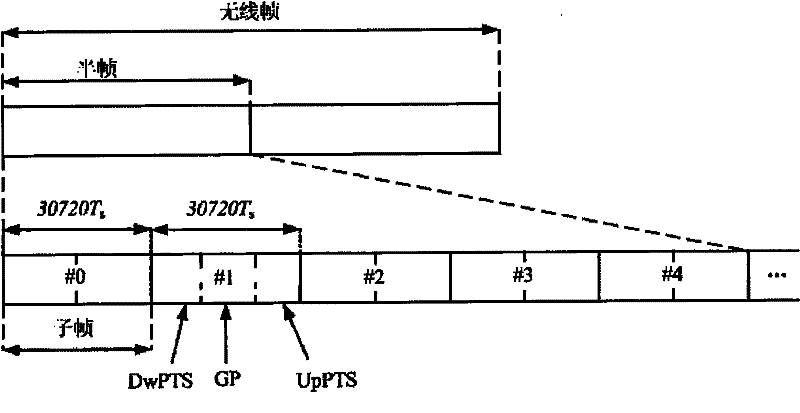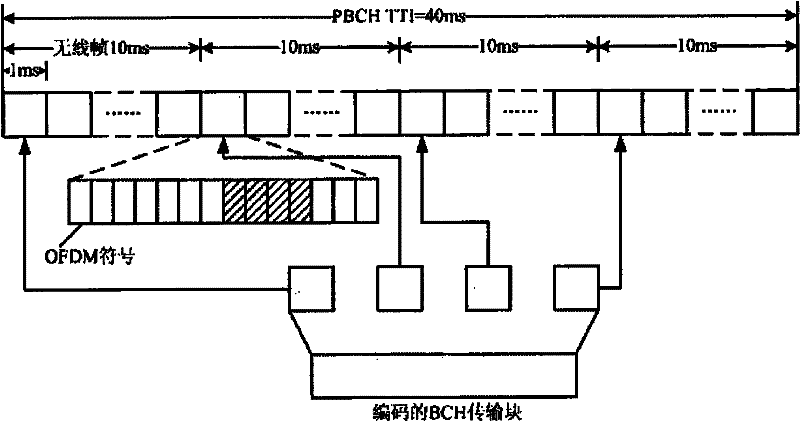System frame number detection method and device for long term evolution LTE system
A system frame number and detection method technology, applied in the field of wireless communication, can solve the problems of high complexity, high terminal power consumption, low efficiency, etc., and achieve the effects of improving efficiency, short detection, and reducing power consumption
- Summary
- Abstract
- Description
- Claims
- Application Information
AI Technical Summary
Problems solved by technology
Method used
Image
Examples
Embodiment approach 1
[0055] Implementation mode 1: Single wireless frame detection system frame number scheme, the process is as follows Figure 6 As shown, the specific steps include:
[0056] 101) The terminal receives a time-domain signal of the first subframe in a radio frame. The CP is removed from the time domain signal, and after OFDM demodulation, the center 72 subcarriers of the first 4 OFDM symbols of slot#1 on the subframe are the PBCH data and corresponding reference signals. Then, the data A to be descrambled is obtained through the steps of resource unit mapping, channel estimation, signal detection and QPSK demodulation. For regular CP, the length of data A is 480; for extended CP, the length of data A is 432;
[0057] 102) Generate a scrambling code sequence C of one TTI. For a regular CP, the length of the scrambling code sequence C is 1920; for an extended CP, the length of the scrambling code sequence C is 1728. Divide the scrambling code sequence C into four segments, which ...
Embodiment approach 2
[0064] Implementation Mode 2: Multiple wireless frames are combined to detect the frame number scheme of the system, and the process is as follows Figure 7 As shown, the specific steps include:
[0065] 201) The terminal receives a time-domain signal of a first subframe in a radio frame. The CP is removed from the time domain signal, and after OFDM demodulation, the center 72 subcarriers of the first 4 OFDM symbols of slot#1 on the subframe are the PBCH data and corresponding reference signals. Then, the data A to be descrambled is obtained through the steps of resource unit mapping, channel estimation, signal detection and QPSK demodulation. For regular CP, the length of data A is 480; for extended CP, the length of data A is 432;
[0066] 202) Generate a TTI scrambling code sequence C. For a regular CP, the length of the scrambling code sequence C is 1920; for an extended CP, the length of the scrambling code sequence C is 1728. Divide the scrambling code sequence C into...
Embodiment approach 3
[0072] Embodiment 3: The frame number scheme of a single radio frame and multiple radio frames combined with a hybrid detection system. The specific implementation steps include:
[0073]301) The terminal receives a time-domain signal of a first subframe in a radio frame. The CP is removed from the time domain signal, and after OFDM demodulation, the center 72 subcarriers of the first 4 OFDM symbols of slot#1 on the subframe are the PBCH data and corresponding reference signals. Then, the data A to be descrambled is obtained through the steps of resource unit mapping, channel estimation, signal detection and QPSK demodulation. For regular CP, the length of data A is 480; for extended CP, the length of data A is 432;
[0074] 302) Generate a TTI scrambling code sequence C. For a regular CP, the length of the scrambling code sequence C is 1920; for an extended CP, the length of the scrambling code sequence C is 1728. Divide the scrambling code sequence C into four segments, wh...
PUM
 Login to View More
Login to View More Abstract
Description
Claims
Application Information
 Login to View More
Login to View More - R&D
- Intellectual Property
- Life Sciences
- Materials
- Tech Scout
- Unparalleled Data Quality
- Higher Quality Content
- 60% Fewer Hallucinations
Browse by: Latest US Patents, China's latest patents, Technical Efficacy Thesaurus, Application Domain, Technology Topic, Popular Technical Reports.
© 2025 PatSnap. All rights reserved.Legal|Privacy policy|Modern Slavery Act Transparency Statement|Sitemap|About US| Contact US: help@patsnap.com



